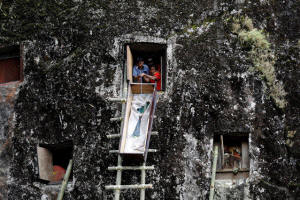|
'You look so beautiful!': Indonesians
celebrate the dead in ancient ritual
 Send a link to a friend
Send a link to a friend
 [September 29, 2017]
By Darren Whiteside [September 29, 2017]
By Darren Whiteside
TORAJA, Indonesia (Reuters) - Yosefina
Tumanan, a resident of the remote Toraja region of Indonesia's island of
Sulawesi, was thrilled to see her sister-in-law.
"You look so beautiful!" Tumanan told the skeletal remains of her
relative who has been dead for six years.
The scene is part of an ancient Torajan ritual known as "Ma'nene", in
which clans visit the tombs of deceased family members, clean their
remains and replenish the coffins with personal belongings.
"Even though she's not here physically, we still have a connection,"
Tumanan told Reuters as several families gathered at Loko'mata, a
massive boulder in a misty, rice-terraced valley that houses the remains
of dozens of people.
"It's a chance for the whole family to visit and express our love," she
said, adding that the ritual was like a family reunion every few years.
The people of Tana Toraja, or "the land of Toraja", are mostly
Christian, but adhere to old traditions whose roots trace back to
animistic beliefs.

This is common in Indonesia, a predominantly Muslim country of 250
million people that is also home to minority groups which espouse
Hinduism, Buddhism, and traditional beliefs.
Unlike some other cultures, death is barely a parting for those in
Toraja.
The deceased are mummified and housed in ornate, colorful coffins and
spend several months or even years in their own homes before receiving a
funeral and burial.
Relatives talk to the deceased, offer them food and drink, and involve
them in family gatherings, as if they are still alive.
[to top of second column] |

Men lower part of a coffin down from a burial chamber cut into a
massive boulder of Loko'mata, a traditional Toraja burial site,
during an ancient Torajan ritual known as "Ma'nene", near Rantepao,
North Toraja, South Sulawesi, Indonesia, September 14, 2017.
REUTERS/Darren Whiteside

Once sufficient family members can attend and money is available to
pay for sacrificial buffaloes and pigs, a funeral ceremony, known as
'Rambu Solo', is held, with the whole village usually invited to a
feast celebrating communal ties.
Family members shed tears for their dead as the coffin is carried in
a chaotic funeral procession to the burial site.
The coffins - painted in bright reds and ochres - are stuffed with
clothes and personal effects and placed in narrow tombs carved into
monolithic rocks that pepper the mountainous region.
The boulders can be as high as a three-storey building and each tomb
can take between three to six months to carve.
Keeping the tradition alive for future generations is an important
responsibility, said Renolt Patrian, a 21-year-old studying to be a
mining engineer.
"When I have a job and earn money, I will not give up the
tradition," he said after visiting his great-grandmother who died
last month in the family home.
(Writing by Kanupriya Kapoor; Editing by Clarence Fernandez)
[© 2017 Thomson Reuters. All rights
reserved.]
Copyright 2017 Reuters. All rights reserved. This material may not be published,
broadcast, rewritten or redistributed.
 |